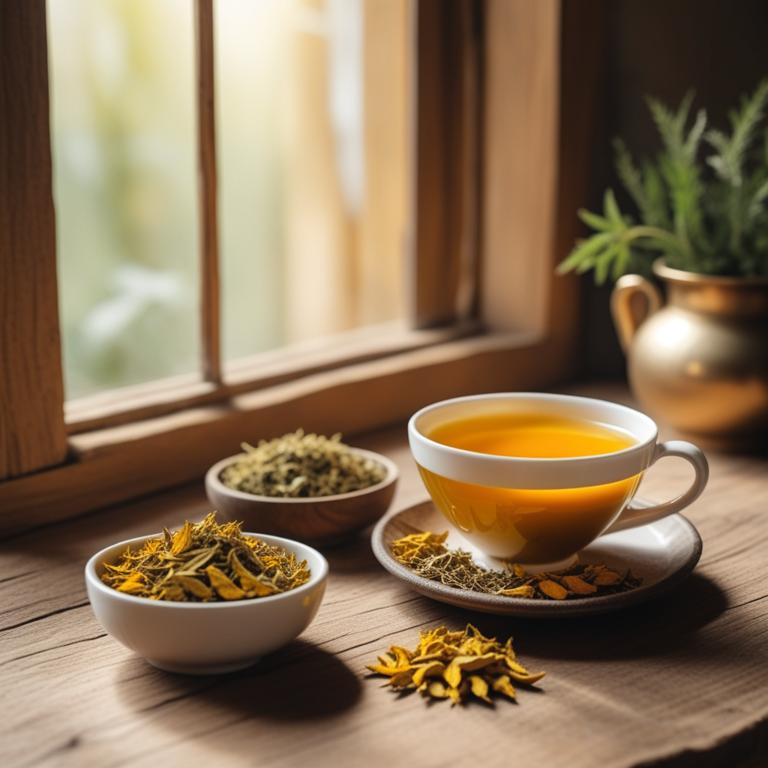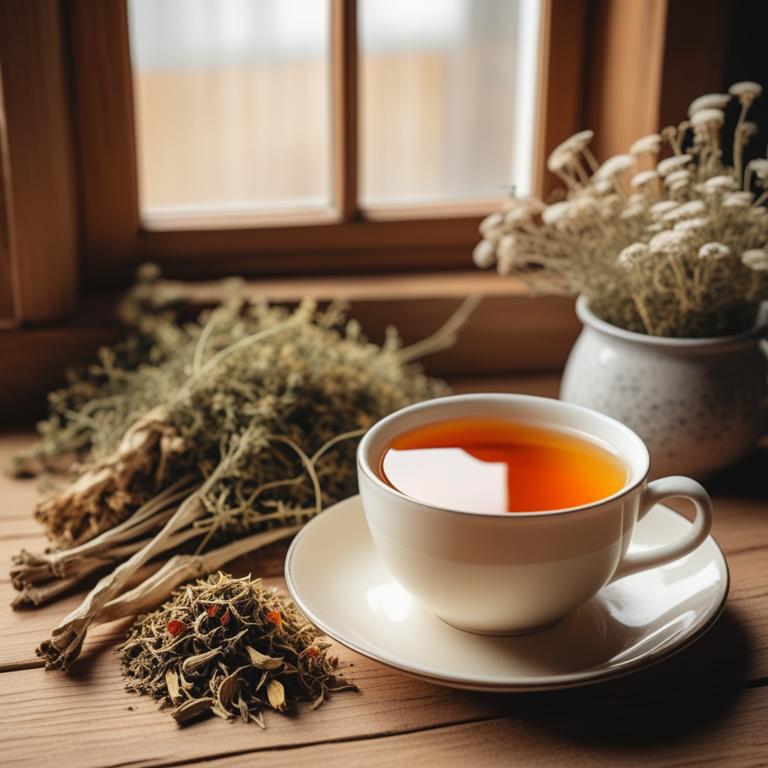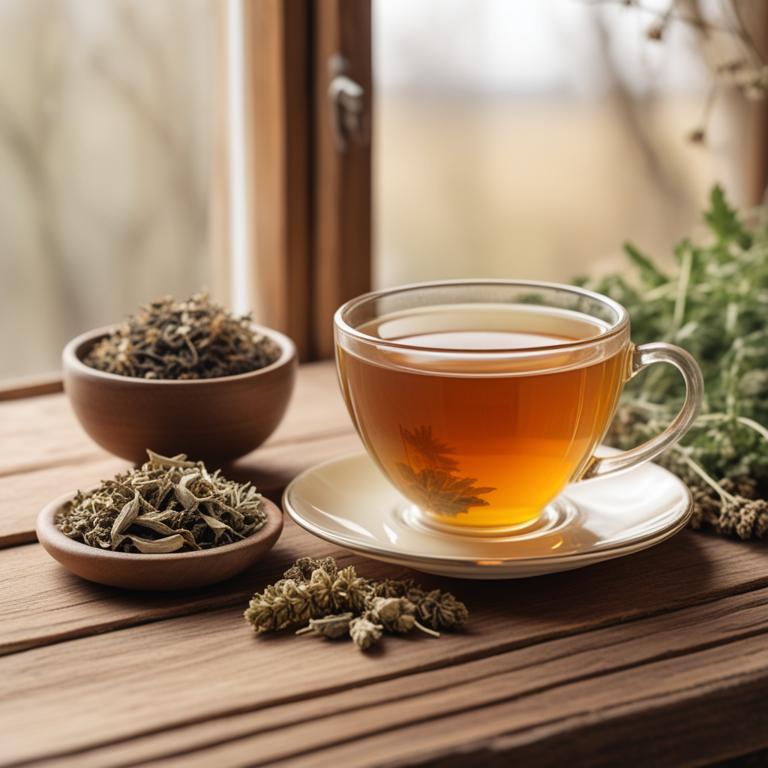8 Herbal Teas For Back Pain

Herbal teas have been a long-standing remedy for back pain, and it's no surprise why.
These teas work by targeting the root causes of discomfort, such as inflammation and muscle tension. For example, Curcuma longa, also known as turmeric, contains a powerful compound called curcumin, which has potent anti-inflammatory properties. This means that it can help reduce swelling and ease pain in the muscles and joints. Another herb that's commonly used to relieve back pain is Zingiber officinale, or ginger. Ginger has natural anti-inflammatory compounds that can help relax tense muscles and improve blood circulation, which can help reduce stiffness and pain. Valeriana officinalis, or valerian root, is also a popular choice for back pain relief.
It contains compounds that can help calm the nervous system and promote relaxation, which can help reduce muscle tension and alleviate pain. Drinking herbal teas can bring many benefits to your life. Not only can they provide relief from back pain, but they can also promote overall relaxation and well-being. Many of these teas can be enjoyed hot or cold, making them a versatile addition to your daily routine. They can also be a gentle and non-invasive way to manage chronic pain, without the need for medication or surgery. Plus, herbal teas are often caffeine-free and low in calories, making them a great alternative to traditional beverages.
By incorporating herbal teas into your daily routine, you can find relief from back pain and enjoy a healthier, more balanced lifestyle.
- 1. Curcuma longa
- 2. Zingiber officinale
- 3. Valeriana officinalis
- 4. Glycyrrhiza glabra
- 5. Lavandula angustifolia
- 6. Echinacea purpurea
- 7. Achillea millefolium
- 8. Ginkgo biloba
1. Curcuma longa

Curcuma longa teas contains a powerful compound called curcumin, which is responsible for its medicinal properties.
Curcumin has potent anti-inflammatory and antioxidant properties that help reduce swelling and pain in the body. It contains a group of compounds called polyphenols, which have anti-inflammatory properties that can help alleviate back pain by reducing inflammation and oxidative stress. Curcuma longa teas also contains other bioactive constituents like turmerone and atlantone, which have anti-inflammatory and pain-relieving effects.
By reducing inflammation and promoting healing, Curcuma longa teas can help provide relief from back pain.
- Get 1 teaspoon of dried Curcuma longa root powder.
- Heat 1 cup of water in a pot.
- Add the 1 teaspoon of Curcuma longa root powder to the hot water.
- Steep for 5-7 minutes, then strain the liquid.
- Drink 1 cup of the Curcuma longa tea 2-3 times a day for back pain relief.
2. Zingiber officinale

Zingiber officinale teas contains a compound called gingerol, which is responsible for its anti-inflammatory properties.
Gingerol helps reduce pain and swelling by blocking the production of prostaglandins, hormone-like substances that cause inflammation. The tea also contains shogaol, a bioactive constituent that has been shown to inhibit the production of pain-causing chemicals. Shogaol's analgesic properties help alleviate back pain by reducing muscle spasms and relaxing the muscles.
Regular consumption of Zingiber officinale teas may help reduce back pain by addressing its underlying causes.
- Gather 1 tablespoon of fresh or dried Zingiber officinale root.
- Boil 1 cup of water in a pot.
- Add the Zingiber officinale root to the boiling water.
- Reduce heat and let it simmer for 5-7 minutes.
- Strain the tea and drink while warm.
Zingiber Officinale Tea on Amazon
FGO Organic Ginger Tea, 100 Count, Eco-Conscious Tea Bags, Caffeine Free, Packaging May Vary (Pack of 1)
Disclaimer: We earn a commission if you click this link and make a purchase at no additional cost to you.
3. Valeriana officinalis

Valeriana officinalis teas contains valerenic acid, isovaleric acid, and valepotriates as its bioactive constituents.
These compounds interact with the nervous system, reducing stress and anxiety that can contribute to back pain. The sedative properties of valerenic acid help calm the muscles, relaxing tension in the back and relieving pain. The anti-inflammatory properties of isovaleric acid reduce swelling and discomfort in the back, while valepotriates further ease muscle spasms.
By addressing the underlying causes of back pain, Valeriana officinalis teas can provide relief from chronic and acute back pain.
- Gather 1 cup of water and 2-3 grams of dried Valeriana officinalis root.
- Heat the water in a pot and bring it to a boil.
- Reduce heat to low and add the dried root. Let it steep for 5-7 minutes.
- Strain the tea into a cup and discard the root.
- Drink 1/2 cup of the tea, 2-3 times a day, to help relieve back pain.
4. Glycyrrhiza glabra

Glycyrrhiza glabra teas contains active constituents like glycyrrhizin and flavonoids that have anti-inflammatory properties.
These compounds help reduce swelling and inflammation in the muscles and joints, which can contribute to back pain. Glycyrrhizin also has a corticosteroid-like effect, which can help reduce pain and inflammation in the body. Flavonoids, on the other hand, have antioxidant properties that can help protect the body from oxidative stress and reduce muscle tension.
By reducing inflammation and muscle tension, Glycyrrhiza glabra teas may provide relief from back pain.
- Gather 1 cup of fresh or dried Glycyrrhiza glabra roots, 1 cup of water, and a tea infuser.
- Rinse the roots with water and chop them into small pieces.
- Place the chopped roots in the tea infuser and steep them in boiling water for 5-7 minutes.
- Strain the tea into a cup and discard the roots. Add 1 tablespoon of honey to taste.
- Drink the tea 2-3 times a day to help relieve back pain. Store any leftover tea in the fridge for up to 24 hours.
5. Lavandula angustifolia

Lavandula angustifolia teas contains linalool and linalyl acetate, two compounds that contribute to its analgesic and anti-inflammatory properties.
These properties help to reduce muscle spasms and inflammation, common causes of back pain. Linalool also has a sedative effect, which can promote relaxation and reduce stress, further alleviating back pain. Additionally, the anti-inflammatory properties of linalyl acetate help to reduce swelling and pain in the affected areas.
By consuming Lavandula angustifolia teas, individuals may experience relief from back pain due to its ability to reduce muscle spasms and inflammation.
- Gather 1 cup of fresh Lavandula angustifolia leaves or 2 tablespoons of dried leaves.
- Heat 1 cup of water until it boils.
- Add the Lavandula angustifolia leaves to the boiling water and let it steep for 5-7 minutes.
- Strain the tea and discard the leaves. Add honey or lemon to taste, if desired.
- Drink 1 cup of the tea 2-3 times a day for relief from back pain.
6. Echinacea purpurea

Echinacea purpurea teas contains bioactive constituents like alkylamides, caffeic acid derivatives, and phenolic acids.
These compounds have anti-inflammatory properties that help reduce swelling and ease pain in the back. Alkylamides, specifically, are known to inhibit the production of pro-inflammatory chemicals, which contribute to back pain. Caffeic acid derivatives, on the other hand, have antioxidant properties that help protect against tissue damage and promote healing.
By reducing inflammation and promoting healing, Echinacea purpurea teas may provide relief from back pain.
- Gather 1 cup of fresh or dried Echinacea purpurea flowers and 1 cup of boiling water.
- Measure 1 tablespoon of dried flowers or 2 tablespoons of fresh flowers.
- Pour boiling water over the Echinacea purpurea flowers in a heat-resistant cup.
- Steep for 5-7 minutes, then strain the tea into another cup using a cheesecloth or a strainer.
- Drink 1 cup of the tea 2-3 times a day to help manage back pain.
7. Achillea millefolium

Achillea millefolium teas contains flavonoids, sesquiterpenes, and volatile oils.
These bioactive constituents have anti-inflammatory and analgesic properties, which help to reduce pain and inflammation in the back. The sesquiterpenes in the tea, such as achilleine, have been shown to inhibit the production of pro-inflammatory enzymes, which contribute to back pain. The flavonoids, including quercetin and kaempferol, have antioxidant properties that help to reduce oxidative stress and inflammation in the body.
By reducing inflammation and pain, Achillea millefolium teas may help to alleviate back pain and promote relaxation.
- Gather 1 cup of dried Achillea millefolium leaves and flowers.
- Measure 1 tablespoon of dried material and place it in a tea infuser or a heat-resistant cup.
- Boil 1 cup of water in a kettle or on the stovetop.
- Pour the boiling water over the dried material in the tea infuser or heat-resistant cup.
- Steep for 5-7 minutes, then strain and drink as needed for back pain relief.
8. Ginkgo biloba

Ginkgo biloba teas contains flavonoids and terpenoids, which are active compounds that help with back pain.
The flavonoids, particularly quercetin and kaempferol, have anti-inflammatory properties that reduce swelling and pain in the muscles and joints. Terpenoids, such as ginkgolides and bilobalide, have antioxidant properties that protect the nerves from damage and improve blood flow, which helps to reduce pain and stiffness in the back. The flavonoids and terpenoids in Ginkgo biloba teas also help to relax the muscles and improve flexibility, making it easier to move and reduce strain on the back.
By reducing inflammation, improving blood flow, and relaxing the muscles, Ginkgo biloba teas can help to alleviate back pain and improve overall mobility.
- Gather 1 teaspoon of dried Ginkgo biloba leaves and 1 cup of boiling water.
- Steep the Ginkgo biloba leaves in the boiling water for 5-7 minutes.
- Strain the mixture into a cup and discard the leaves.
- Add honey or lemon to taste, if desired.
- Drink the tea 2-3 times a day to help alleviate back pain.